Key Takeaways
- Carpet beetle larvae feed on natural fibers, damaging fabrics and upholstery.
- Infestation signs include fabric damage, pet hair, larvae, and adult beetles.
- Vacuum often, store fabrics safely, and use natural repellents to prevent infestations.
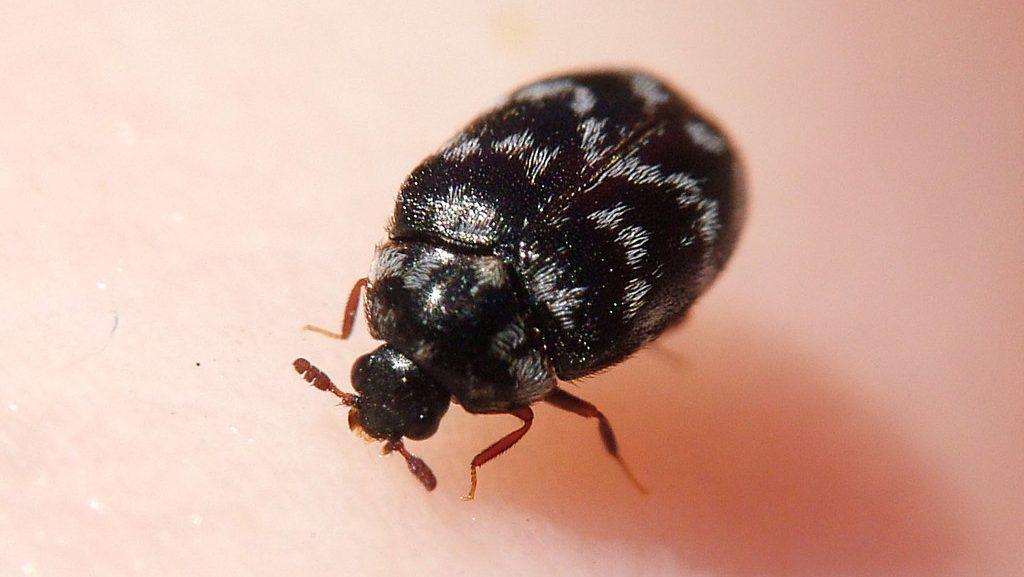 Carpet beetles are a common household pest that can do serious damage to your property. Although they are small in size, these pests can cause expensive cleaning and damage. This article gives insights into how carpet beetles look, how to identify their eggs, and even how they can result in skin rashes.
We’ll also debunk some common misconceptions about these pests to help you better understand how to deal with them in your house.
Carpet beetles are a common household pest that can do serious damage to your property. Although they are small in size, these pests can cause expensive cleaning and damage. This article gives insights into how carpet beetles look, how to identify their eggs, and even how they can result in skin rashes.
We’ll also debunk some common misconceptions about these pests to help you better understand how to deal with them in your house.
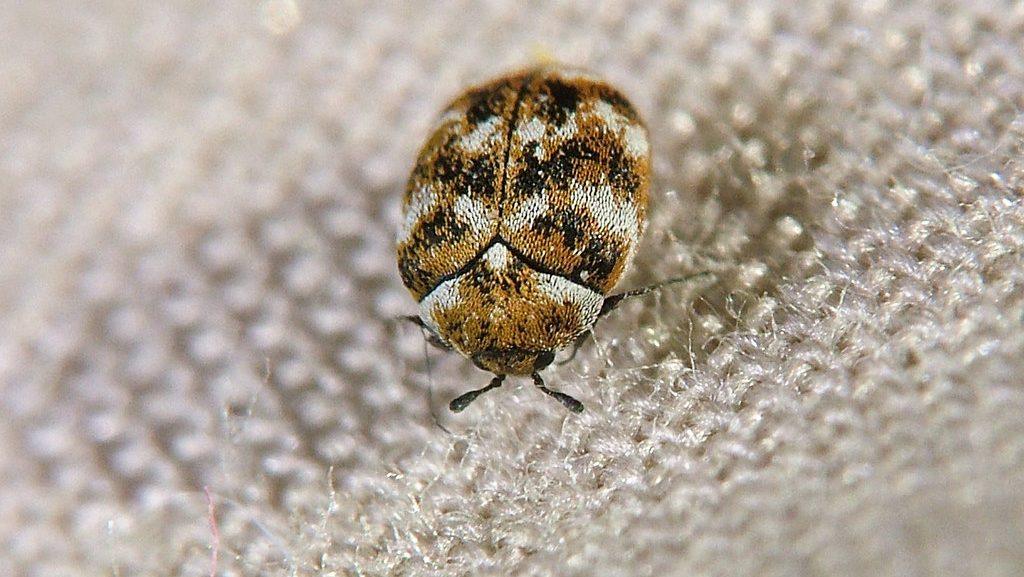

Not getting a solution?
Get your free pest control estimate today!What is a Carpet Beetle?
Carpet beetles are members of the Dermestidae family and are known for their destructive larvae. Adult carpet beetles are mostly harmless and feed on pollen and nectar. Carpet beetle larvae, on the other hand, are often more dangerous than the adults. The light brown larvae are covered with bristle-like hairs that help them navigate fabric and materials. They have the ability to damage carpets, furniture, clothing, and even stored foods.What Does a Carpet Beetle Look Like?
Carpet beetles are very small, measuring around 1/8 inch (3-5 mm) in length. They are oval-shaped with a hard shell. Their elytra and hardened forewing have a distinctive, colorful pattern that can include combinations of black, white, yellow, and orange. The appearance of carpet beetles can vary depending on the species, but they typically have distinctive patterns on their bodies that help in their identification. Below are some common carpet beetles you might spot in your locality. Variegated Carpet Beetle: This beetle has a mottled appearance with yellow, white, and black markings. Adults are small (3-5 mm), while larvae, covered in bristles, damage wool, silk, and other natural fibers in homes. Black Carpet Beetle: Solid black or dark brown, these beetles measure 3-5 mm. Their larvae, reddish-brown and bristly, feed on wool, furs, and feathers, causing significant damage to fabrics and carpets if left uncontrolled. Furniture Carpet Beetle: With a tan or light brown body and black spots, this small beetle (2-4 mm) damages wool, fur, and feathers. Larvae often infest furniture or stored items, requiring cleaning and pest control. Carpet beetles prefer hiding in dark, undisturbed areas. Common signs of carpet beetle infestation include damaged fabrics, shed larval skins, and adult beetles near light sources. Our pest control professionals provide a customized approach to protect your home effectively.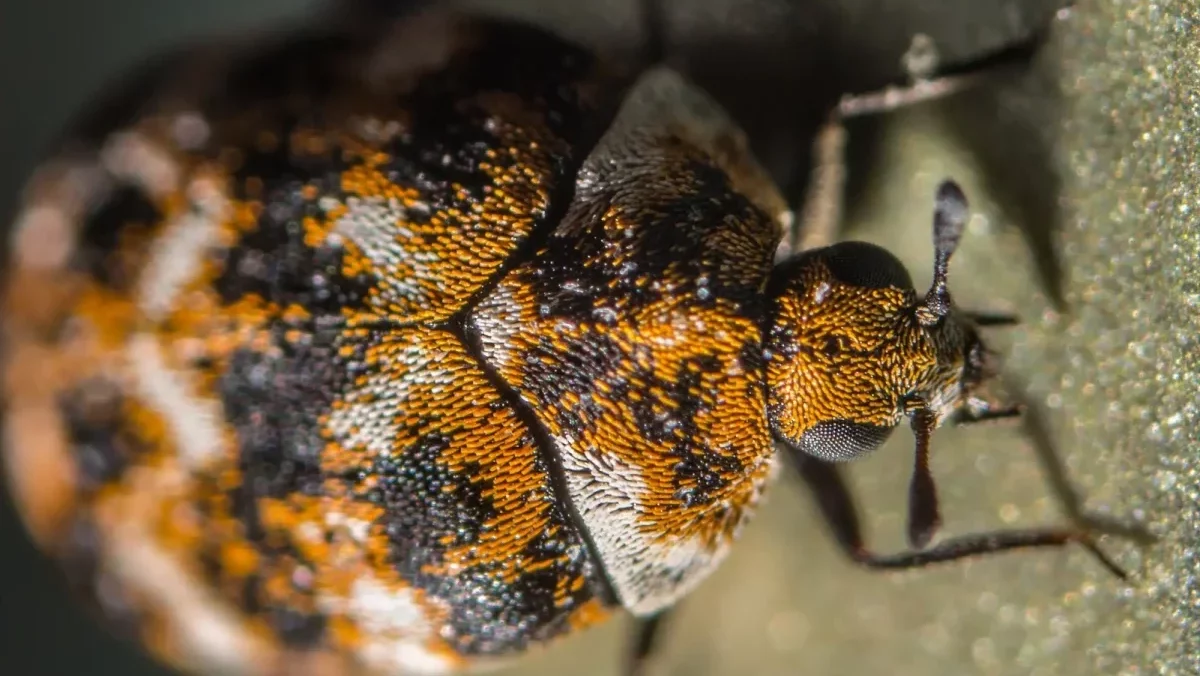
Life Cycle of Carpet Beetles
- The life cycle of carpet beetles includes four stages: egg, larva, pupa, and adult. Understanding each stage is vital for effective control.
-
Egg: Female carpet beetles lay 20 to 100 eggs in dark, undisturbed areas near food sources. The eggs hatch in about two weeks.
-
Larva: This stage is the most damaging. Known as “woolly bears” for their hairy appearance, larvae consume and damage natural fibers such as wool, silk, leather, and feathers. Depending on conditions, the larval stage can last several months to over a year.
-
Pupa: After the larval stage, beetles enter the pupal stage, developing into adults. This stage lasts a few weeks.
-
Adult: Adults emerge from the pupal stage ready to lay eggs and mate to continue the cycle. Adults live for several weeks to months.
What Do Carpet Beetle Eggs Look Like?
Carpet beetles prefer laying their eggs in hidden areas, such as cracks and gaps, behind furniture, and in closets. The eggs are tiny, around 0.5 mm long, and white or cream. When the eggs hatch, larvae begin to feed on fabrics and other organic materials. The eggs are difficult to spot with the naked eye, but if you notice damage to your belongings, such as holes in wool rugs, you might have a carpet beetle infestation.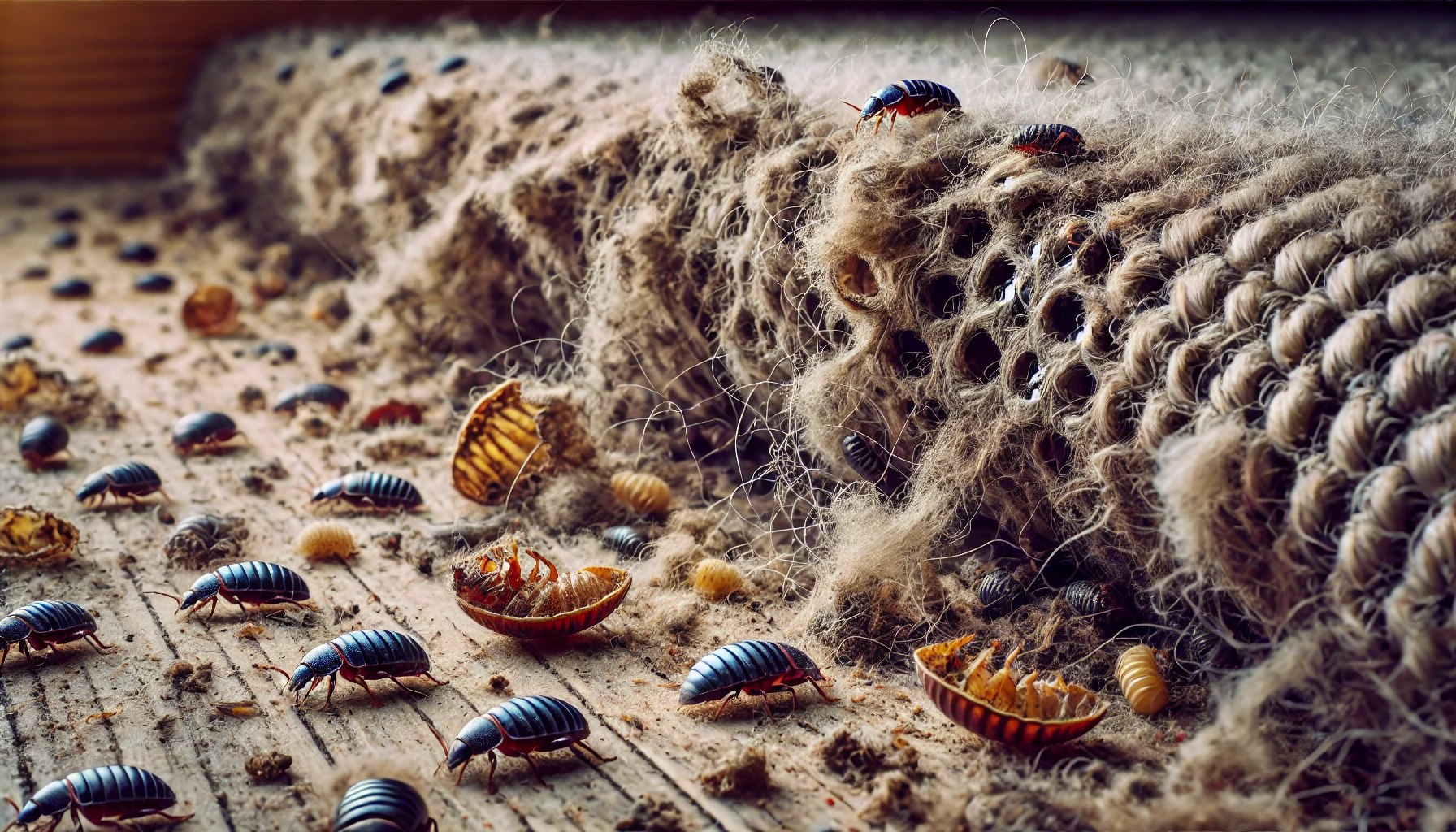
Signs of Carpet Beetle Infestation
- Here are some common signs that you might have carpet beetles in your home:
-
Damaged Fabrics: Carpet beetle larvae feed on natural fibers, such as wool, cotton, and silk. Look for holes or thinning fabric on clothing, carpets, and upholstery.
-
Pet Hair and Dust: Carpet beetles are attracted to pet hair, dust, and other organic debris. If you notice unusual debris around your home, especially in hidden areas like under furniture, it could indicate a carpet beetle infestation.
-
Larvae: Carpet beetle larvae are common in areas where they have been feeding. They look like small, hairy worms and can be seen crawling on furniture or hidden within fabric.

Preventing Carpet Beetles
Carpet beetles can damage fabrics and furnishings if not managed effectively. Preventing infestations involves consistent cleaning and protective measures to wipe out their food sources and entry points. Here are some practical tips to prevent carpet beetle infestations:Tips to Prevent Carpet Beetles
-
Vacuum Regularly: Clean carpets, rugs, furniture, and corners to remove larvae and food debris.
-
Store Items Properly: Use airtight containers for clothes, linens, and fabrics to block beetle access.
-
Seal Entry Points: Close off gaps around windows, doors, and vents to stop beetles from entering.
-
Inspect and Clean Hidden Areas: Clean under furniture, inside closets, and overlooked spaces regularly.
-
Use Natural Repellents: Place cedar chips or lavender sachets in storage to naturally deter beetles.
-
Monitor Infestation Signs: Look for larvae, shed skins, or adult beetles and act quickly if found.
-
Reduce Attractants: Keep dust, pet hair, and food crumbs to a minimum to avoid beetle attraction.
-
Wash Fabrics: Wash fabrics periodically in hot water to kill hidden eggs or larvae.
-
Use Insecticides if Necessary: Apply safe, targeted insecticides as directed in known infestation spots.
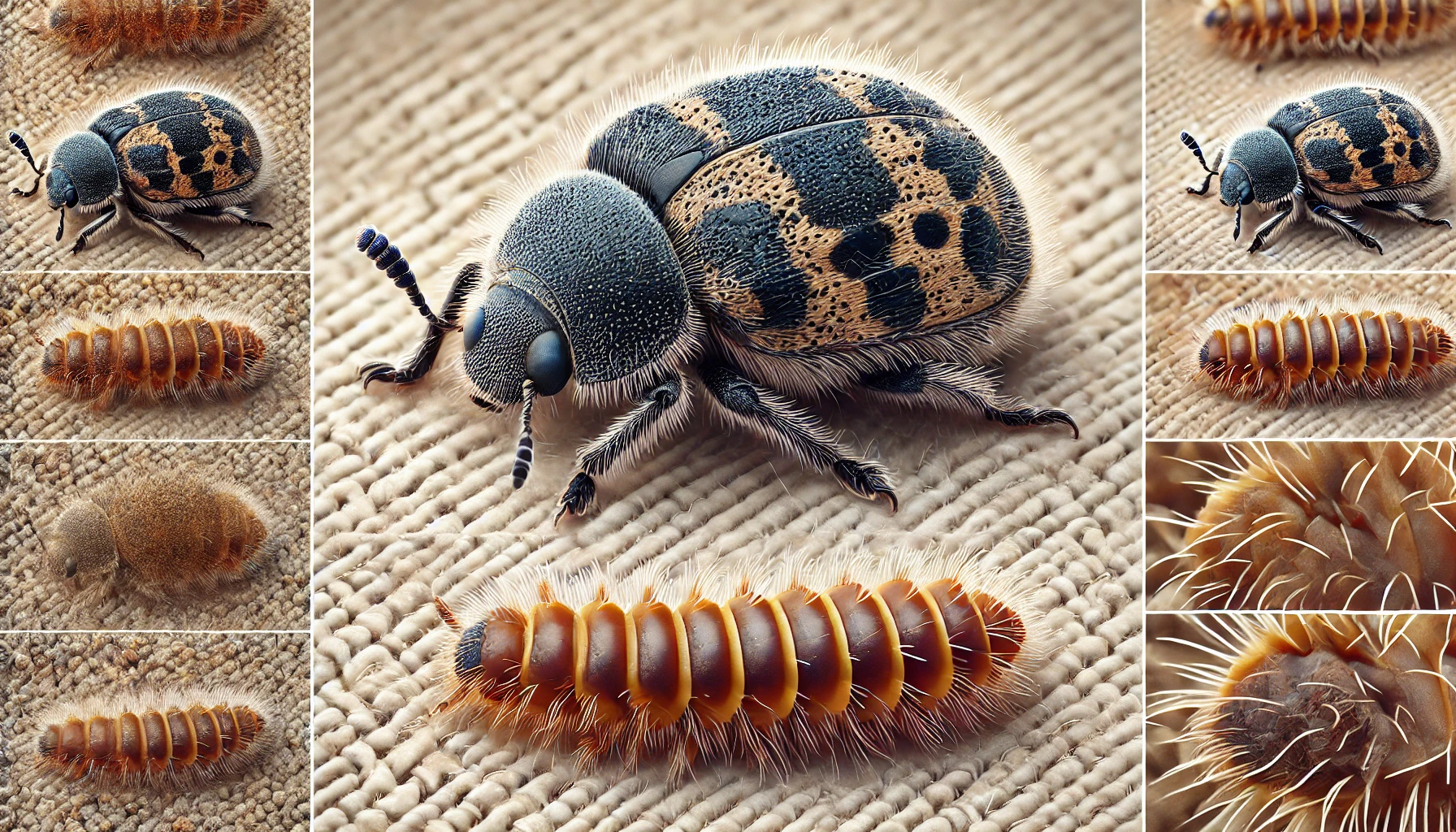
Controlling Carpet Beetles
If Carpet Beetles have already invaded your home, deep clean infested areas by vacuuming and steam cleaning carpets and space under furniture. Throw out vacuum bags immediately to prevent re-infestation. You can also use insecticides specifically labeled for carpet beetles. Follow the instructions carefully to apply them in areas where larvae and adults are found. Consider hiring pest control professionals. Our pest control professionals provide a customized approach to protect your home effectively.Myths and Facts About Carpet Beetles
Several misconceptions about carpet beetles can lead to confusion when managing an infestation. Being aware of the truth behind these myths is key to effectively preventing and controlling carpet beetles.| Myth | Fact |
|---|---|
| Carpet beetles only live in carpets. | Carpet beetles can infest natural fiber materials, including clothing, furniture, and stored products. |
| Carpet beetles are always visible. | While adult beetles may be visible, larvae hide in dark, undisturbed areas, making early detection challenging. |
| Regular vacuuming eliminates carpet beetles. | Vacuuming helps but may not reach all larvae and eggs. Additional measures like insecticides are often necessary. |
| Carpet beetles only infest dirty homes. | Carpet beetles can infest any home, as they are attracted to natural fibers, not dirt. |
| Only chemical treatments can eliminate carpet beetles. | A combination of thorough cleaning, proper storage, and insecticides is often more effective than relying solely on chemicals. |





